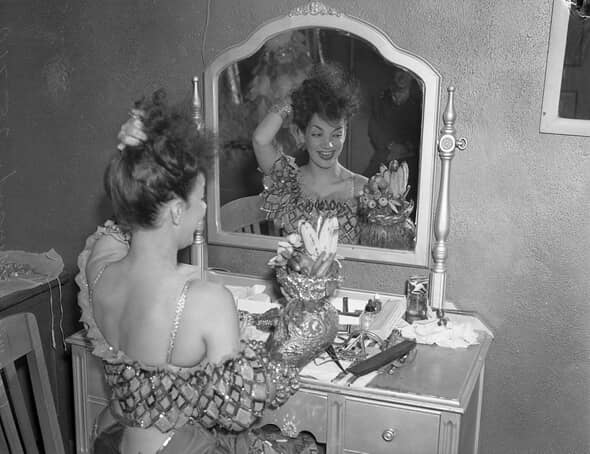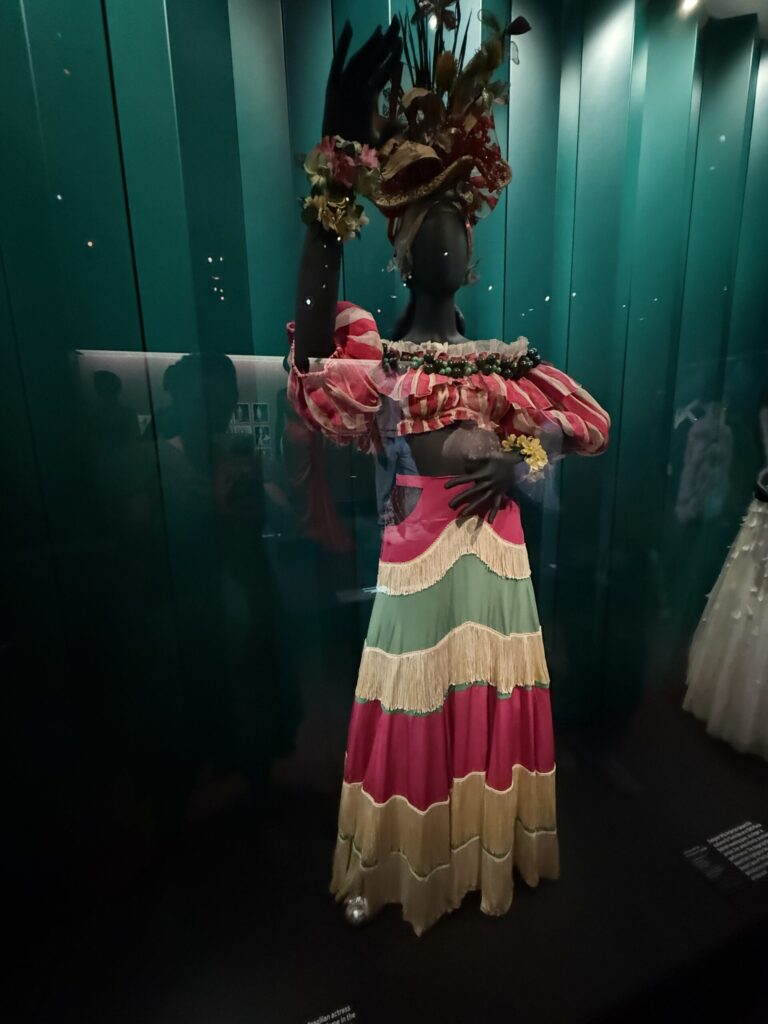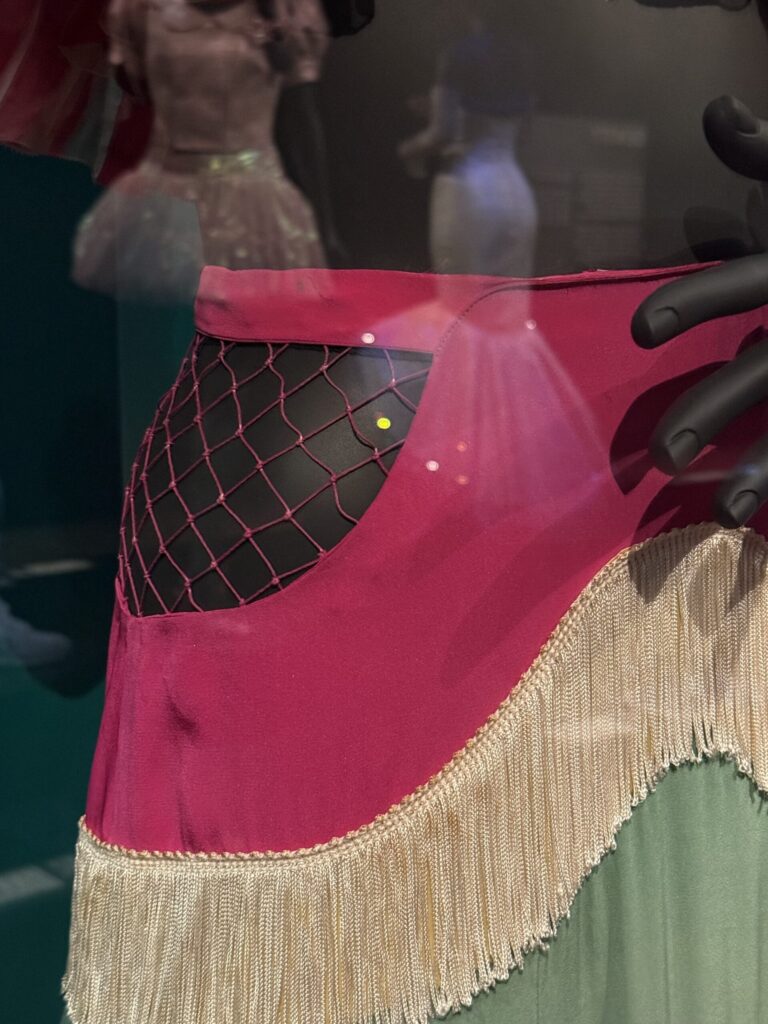An observation and commentary on Carmen Miranda’s identity and generational feeling of displacement among the Latino diaspora

By Eda Del Rio
Director of Latinx Experience
Hollywoodland News
Not All of Us Protest Physically
Not all of us protest physically. I chose to become a perpetual student of art, humanities and the Latino experience. In the last year, I committed to 12 books as a starting point and have read 7 so far. The last book I finished was the biography of the Brazilian bombshell Carmen Miranda.
Despite years of work and impact in the U.S., she was still left feeling like an outsider—just in 3 countries instead of 1. Decades after Carmen Miranda’s death, Latinos in the U.S. are still struggling with feelings of displacement. But now we’re facing even more dangerous terrain under an occupied U.S. government.

Our people are being kidnapped for deportation. Our government is threatening to reverse the citizenship of many. Given how many years have passed between Carmen Miranda and the generation of today, I find it unsettling how little has changed.
I think it begs the question: how can our Latino community reshape the definitions of home and community to combat the American fascist party and this feeling of generational homelessness?
This entire piece is grounded in the evolution and heartbreak of Carmen Miranda’s identity, and how that echoes across generations.
How Carmen Miranda’s Identity Became a Latin American Export
When Carmen was asked about home, she called herself a “daughter of Portugal” but said her soul was all Brazilian. Before her American success, she was a beloved RCA recording artist in Brazil, performing for packed houses and adoring fans.
The “Pequena Notável” and her bewitching samba were too big for one continent, so she continued north.

She proudly claimed Brazil and spoke of it fondly in interviews even after her home country turned cold toward her American success. Her supposed “Americanization” became a wedge.
In the U.S., Carmen became a true vedette—singing, dancing and acting on stage and screen. At one point, she reportedly earned more than Cary Grant. By the 1940s, Carmen Miranda was a household name. Her fashion trends were copied by Hollywood stars. Her voice and style were everywhere. But despite the influence and money, Carmen Miranda’s identity became a spectacle for white America to consume and caricature.
She was turned into a tropical fantasy: bare midriff, fruit hat, no borders. Just palm trees, piña coladas and pretty women. That distorted image poisoned her standing in Brazil. When she returned for a performance at the Cassino da Urca, she was booed by her own people.
Some say she never recovered.
Carmen spent the rest of her life terrified to return.
Many close to her believed she worked herself to death, desperate to feel loved by both the U.S. and Brazil.
Neither Here Nor There: A Personal Reflection
I’ve never been to Portugal. I was born in the U.S. and have no connection to Brazil. And still, I feel Carmen’s heartbreak in my bones.
For years, I proudly identified as Colombian instead of American even when close friends joked about how American I could be. I was born in Florida, but when I closed our front door, my world was Colombian.
Our house smelled like arroz y frijoles. On Sundays we hung laundry while my parents’ vallenato records played through the open windows. Spanish was my first language and even after learning English in preschool, we spoke Spanish at home.
But I was also raised with Rodeo Day instead of Presidents’ Day. My playlists included country music and sometimes I drop a “y’all” mid-sentence. As they say, I was neither here nor there.

On a visit to Colombia, I remember someone calling out “¡Oye gringa!” and realizing it wasn’t for some passing tourist. It was for me.

I spoke what I thought was fluent Spanish, but it was slower, simpler than what my family used. In a room full of people who looked like me, I was still the outsider. At one point, a neighborhood boy even dedicated a song to me called La Gringa. It hit me: I was a new kind of “No Sabo Kid.”
Not a person.
A floating territory. A place unclaimed.
Just like Carmen Miranda’s identity, mine wasn’t enough for either country.
Why Carmen Miranda’s Identity Still Speaks to Latinx Displacement Today
The feeling of having nowhere to call home shows up in many forms. Immigrants across the U.S. are asking themselves where they belong, thanks to political violence and racism that’s been normalized by Donald Trump and the infestation of MAGA.
I think of friends who’ve been deported. Of families torn apart. Of strangers like Gladys and Nelson Gonzalez. Forty years in the U.S. Three citizen-born kids. A new grandbaby.

It didn’t matter. In February 2025, at a routine immigration check-in, they were arrested and deported. leaving behind everything.
Even legal Latinx citizens don’t feel safe. I’ve heard people say they’re afraid to visit their home countries—afraid they won’t make it back. Afraid a random act of profiling will erase decades of labor, taxes, sacrifice and dreams.
This is why Carmen Miranda’s identity still matters. Her story wasn’t just showbiz. It was survival in a world that couldn’t figure out what to do with someone who didn’t fit a box.
Creating Community in the In-Between
And yet, there is hope. I’ve found it in stories. In books. In spiritual connection. In chosen community.

Our struggles aren’t new and our ancestors left us maps. Carmen didn’t wait for a nation to claim her. She made a home in Beverly Hills. She turned her house into a sanctuary for her Brazilian family.
Any kind Brazilian passing through L.A. knew they could find food, laughter and shelter in her space.
That’s what we need now.
Carmen Miranda’s identity became most powerful when she stopped chasing outside approval and began building her own version of belonging.
Displacement, deportation and generational homelessness won’t stop with Latinos. Haitian communities are under attack too. And we know others are next. The solution? Cross-cultural solidarity.
Eat where you’re welcomed. Shop where you’re seen. Use your phone and social media to find people who speak your language: spiritually, politically, emotionally. Join a group. Read a book. Support independent media. Light a candle. Talk to your ancestors.
I’ll never meet Carmen Miranda. But because of her, I feel less alone.
Let’s build and hold onto community so we never have to feel alone again.
📚 Resources to Help You Go Deeper
- Book: Brazilian Bombshell: The Biography of Carmen Miranda by Martha Gil-Montero
Read the PDF - Watch: Carmen Miranda’s lyrical response to Brazil’s criticism
Watch on YouTube - Read: English translation of lyrics
- Act: Donate or share to the National Immigrant Justice Center
About the Author:
EDA DEL RIO

A proud 1st generation American born from a family of Colombian immigrants, published pinup and clothing model, living on the east coast but making waves towards the west coast through activism, research and discussion about the Latino experience through the years.
A proud 1st generation American born from a family of Colombian immigrants, published pinup and clothing model, living on the east coast but making waves towards the west coast through activism, research and discussion about the Latino experience through the years.
Eda’s experience and passion for work with diversity and minority communities started with a career in education and career services with individuals of varying cognitive abilities. Along the way her experience has expanded to include working with small businesses and non profit organizations, marketing and content creation, and creating collaborative spaces for Latinos in the Virginia area.
She’s found confidence and voice through the world of pin up and the unapologetic females of the Golden Age of Hollywood. Eda is choosing to combat the idiocracy and supremacy with everything they lack. Emotion, intelligence, perception and experience. The cure for it all will be found in our books, our arts, and the stories of our people.
You can find Eda on Instagram @Eda.DelRio





Leave a Reply